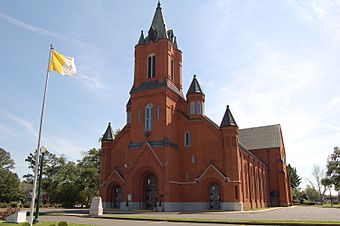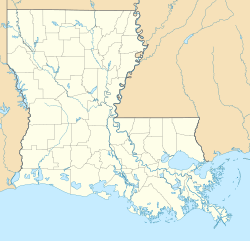St. Landry Catholic Church facts for kids
Quick facts for kids |
|
|
St. Landry Catholic Church
|
|
 |
|
| Location | 1020 N. Union St., Opelousas, Louisiana |
|---|---|
| Area | 1.4 acres (0.57 ha) |
| Built | Completed April 1909 |
| Architect | T. G. Chachere; Owen & Diboll |
| Architectural style | Romanesque Revival |
| NRHP reference No. | 82004675 |
| Added to NRHP | May 3, 1982 |
St. Landry Catholic Church is a very old and important church in Opelousas, Louisiana. It is a Roman Catholic church named after Saint Landry of Paris, who was a bishop around the year 650 AD. The beautiful church building you see today was finished in 1909. It has a mix of Gothic and Romanesque Revival styles. This church and its cemetery were added to the National Register of Historic Places in the United States on May 5, 1982. This means they are special historical places. By 1792, the church's name had changed from its first title, "Parish Church of the Immaculate Conception of the Post of Opelousas."
Contents
History of St. Landry Church
Early Beginnings
In the early 1700s, many Catholic families settled in the area now known as Opelousas. Many of them came from Nova Scotia. They did not have a church building yet to worship in. However, church activities still happened. The first recorded baptism took place on May 16, 1756. It was performed by Father Pierre Didier at the home of Jacques Courtableau. This home is now located in Washington, Louisiana.
Church records show that a Capuchin friar, Friar Valentin, was the first priest to live in the area in 1764. Capuchins are a type of Catholic religious order. By the end of 1765 or early 1766, a church made of cypress wood was built. It was located along the Opelousas River, which is now called Bayou Courtableau. This became the main church for the parish between 1766 and 1770. The church was rebuilt in 1774, a bit north of where Bayou Carron is today. The first name for this church was "Parish Church of the Immaculate Conception of the Post of Opelousas."
Building the First Churches
Worship at the church's current location started in 1798. A new building made of wood was finished there. At this time, the parish name changed to "The Church of St Landry." No exact records exist for the very first church's spot. But it is thought to have been south of present-day Washington, Louisiana, near a bayou.
Michel Prudhomme donated a large piece of land for the church. Another person, Mrs. Tesson, also donated land. This land was between the church's current spot and Bayou Tesson. The land donations happened on October 16, 1796. Later, the land from Mrs. Tesson was sold to the Marguilliers. Marguilliers were churchwardens. These were laypeople, meaning not priests, who managed the church's property and money. They often had a lot of control over the church, even the priests' salaries. Michel Prudhomme is buried inside the nave of the current church. The nave is the main part of the church where people sit. Michel Prudhomme's old French Colonial home, built around 1790, is still standing near the church. It is also on the National Register of Historic Places.
A New Brick Church
By the mid-1800s, the old wooden church built in 1797 was falling apart. It had lasted about 50 years. Bishop William Louis Dubourg visited and suggested building a new church. He hoped it could be made of brick. Finally, on March 4, 1828, a new brick church was blessed by Bishop Rosati. This church was about 60 ft × 40 ft (18 m × 12 m). Later, Father Gilbert Raymond made it bigger, expanding it to 100 feet (30 m) wide.
Father Gilbert and his brother, Father J. Francois Raymond, led the parish for 35 years. They started a school for boys called St. Mary's Academy for Boys in 1855. Father Gilbert also wanted girls to have a good Christian education. So, he bought land and started the Academy of the Immaculate Conception in 1856.
Schools and Community
In 1870, Father Gilbert Raymond bought more land. He wanted to create a school for the Black children of the parish. This school was named St. Joseph's School. In 1971, all these schools combined to form Opelousas Catholic School.
In 1895, Father John Engberink became the pastor of St. Landry. He decided to build a brand new church building. This was a huge project. It would be a great place for the people of St. Landry parish to worship. Work to remove the old church began in 1902. A temporary church was used starting in 1900 while the new one was being built. The new rectory, where the priests live, was also ready then. The old bricks from the previous church were saved. They were used in the foundation of the new church.
The Grand New Church
The actual construction of the new church started in September 1903. The foundation was very strong. It was made of concrete, 6-by-1-foot wide/deep (1.83 m × 0.30 m), and started 7 feet (2.1 m) below the ground. It was built four feet above the ground and given plenty of time to harden. The walls began to go up in the winter of 1908-09. The church was finished and used for the first time on the first Friday of April 1909. The cornerstone, a special stone laid to mark the start of construction, was placed on August 8, 1908.
The new church was very large. It was 189 by 94 feet (58 m × 29 m) wide in the transepts. The transepts are the parts of a cross-shaped church that stick out on the sides. The main body of the church was 74 ft wide (23 m). It could seat about 2000 people! For many years, it was the second-largest church in the South. It is also the second-oldest parish in its diocese. The inside of the church was not fully completed until the early 1920s because there wasn't enough money.
Completing the Church and Its Legacy
In 1919, Monsignor Albeit Benedict Colliard became the pastor after Father Engberink passed away. Monsignor Colliard took on the job of finishing the church. He paid off the big debt from building the church. He also added beautiful stained-glass windows. When the church was first built, its tower only had a flat roof. But Monsignor Colliard added the tall steeple in 1940.
In 1920, Black parishioners started their own church. It was called Holy Ghost Catholic Church and was about a block away. This happened because they were limited to only two pews at the back of St. Landry Church.
Monsignor Colliard died on May 7, 1950, at age 69. He is buried in the St. Landry Catholic Cemetery. Monsignor Broussard became the next pastor in 1950 and stayed until 1972. He restarted a boys' school. He also moved the academy, which is now Opelousas Catholic School, to a new location east of the church. He had a new two-story rectory built north of the church. In 1963, he had the inside of the church redecorated and air conditioned.
The church and its cemetery were officially added to the National Register of Historic Places on May 5, 1982. This recognizes their importance in history.
To this day, 33 pastors and many assistants have served the people of this parish. Monsignor Russell J. Harrington is the current pastor. He is helped by Permanent Deacons John W. Miller, Sammy Diesi, and Dwayne Joubert.
Father Joseph Verbis Lafleur, who is being considered for sainthood in the Catholic Church, was once a priest at this church.
The church parish is named after its patron saints: Saint Landry the Confessor and Our Lady of the Immaculate Conception.



